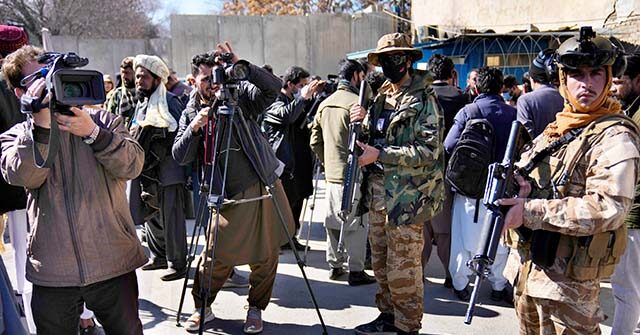Multiple reports this week from various Afghan provinces indicated that the Taliban terrorists in charge of the country have begun enforcing a ban on the publication of pictures and videos of living things, human or otherwise, in mass media – effectively rendering journalism impossible.
The Associated Press reported on Thursday that Helmand became the latest province to impose the ban this week after Taliban terrorists published an extensive list in August of new rules, allegedly based on the Islamic sharia, micromanaging the lives of Afghan citizens. Among the new provisions were detailed rules on how men should maintain their facial hair and a blanket ban on women showing their face or using their voice in public.
One of the provisions reportedly banned the “publication of images of living beings,” according to the Associated Press. It followed a declaration by “Invitation and Guidance Directorate” chief Mohammad Hashim Shaheed Wror in February that taking photos is a “major sin.”
“You, media workers, grow your beards, stop shaving. Do not waste your time by taking pictures because it is a major sin,” Shaheed Wror said at the time, according to the Afghan independent outlet Tolo News. “In the other world, Allah will order you to provide soul to your pictures, then you will be unable to.”
The Taliban, jihadist terror organization, has governed Afghanistan since August 15, 2021, when they seized the nation’s capital, Kabul, without a fight. The Taliban launched a terror campaign earlier in the year in response to President Joe Biden announcing that he would extend the 20-year-old Afghan War beyond a May 1, 2021, deadline that predecessor Donald Trump had agreed to in a deal with the Taliban that would have maintained the U.S.-backed government in power.
“Last week, Taliban run-media stopped showing images of living things in the provinces of Takhar, Maidan Wardak and Kandahar in observance of the laws,” the Associated Press explained on Thursday. “Some private channels are reported to have also stopped running pictures and videos of living things to ensure compliance.”
An anonymous journalist told the British Independent that the restriction allowed media to show only images of “buildings, banners, and empty spaces,” as well as “landscapes and mountains.”
“It is a worsening situation for me and other photojournalists. This puts an end to our work of taking photos. If I don’t take pictures, then I don’t get paid. I get paid for the photographs I send to news agencies,” the journalist lamented.
Mohammad Graan, president of the Afghanistan chapter of the South Asian Association of Reporters Club and Journalists Forum, remarked to Voice of America that reports of the Taliban enforcing the ban with private journalists do not appear to have corresponded yet to official Taliban outlets censoring themselves – or Taliban terrorists ceasing to appear for photo opportunities with allies or partners.
“The Taliban say that taking pictures or videos is forbidden, but they talk at press conferences in front of TV cameras and appear on TV,” Graan observed.
English-language outlets controlled by the Taliban at press time continue to boast photos of humans and other living things. The front page of the Taliban-controlled Bakhtar News Agency, for example, contained many photos of Taliban leaders. Twitter accounts run by senior Taliban terrorists also routinely share photos of Taliban meetings and alleged progress in developing the country’s infrastructure and other basic government services. Acting Minister of Water and Energy Abdul Latif Mansoor, for example, published several photos of terror leaders posing for the camera on Friday.
The account of the office of the Taliban “deputy prime minister for economic affairs,” Mullah Abdul Ghani Baradar Akhund, published similar images of the official posing with an alleged highway reconstruction project.
“Interior Minister” Sirajuddin Haqqani, one of the world’s most wanted terrorists, posed for a glowing New York Times profile published on Thursday.
Taliban terrorists have not clarified at press time if they would end their propaganda operations featuring images of themselves as part of the crackdown on legitimate journalists using photos of living things.
The absurd restriction is one of many that the Taliban have imposed since returning to power. While Taliban leaders promised they would build an “inclusive” government after U.S.-backed leaders fled the country, they have largely reconstructed the repressive regime they governed before 2001, when a U.S. invasion forced them out of power. Many of the Taliban’s biggest human rights violations concern women, including the ban on them showing their faces in public and a ban on women goin to school. In early October, the BBC found evidence that Taliban “judges” had begun using their power to overturn legal divorces granted to victims of child marriage, potentially forcing the “child brides” back under the control of a partner they had no choice in marrying. Taliban leaders have also banned mixed martial arts out of fear it is insufficiently “Islamic” and tightly regulate music.
While the United Nations has occasionally condemned the Taliban for its abuses and no country has yet to recognize the Taliban as a legitimate government, the terrorists have slowly increased their geopolitical influence and face no significant organized political opposition at home. Multiple countries have accepted the Taliban as the “interim” government of Afghanistan, most prominently China, which has greatly expanded its trade with the country since 2021. Chinese Ambassador to Afghanistan Zhao Xing announced on Thursday that the Communist Party has approved and will soon implement “zero-tariff” trade with the terrorists.
In September, Taliban “foreign minister” Amir Khan Muttaqi celebrated that the Taliban is now in control of 29 Afghan diplomatic missions around the world.



